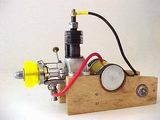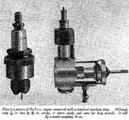| Name | 1cc Two-Stroke Petrol Engine | Designer | WH Deller |
| Type | Two-stroke, Spark Ignition | Capacity | 1cc (nominal) |
| Production run | N/A (plan only) | Country of Origin | England |
| Photo by | Ken Croft/Les Stone | Year of manufacture | Published 1938 |
Background
George Newnes began his publishing business in 1881 with a paper called Tit-Bits. Others followed; The Review of Reviews, The Strand Magazine, The Picture Magazine, and perhaps most notably, The Wide World Magazine ("Truth is Stranger than Fiction") which continued publication until 1965. In October 1933, Newnes Ltd launched Newnes Practical Mechanics. This monthly magazine reamined in publication until August 1963. During that time, it presented how-to articles on a wide variety of topics, including in 1935, the first English language publication of plans for Henri Mignet's famous (or should that be infamous) Flying Flea. Other, later and longer lived Newnes "Practical" magazines followed. These included Practical Wireless, Practical Television, and Practical Electronics. I have fond school-boy memories of these, especially Practical Wireless, having built a guitar amp from a pull-out plan that appeared in about 1963. A pair of push-pull 807's delivering an unconscionable amount of noise for those days, but I digress...
In the November 1936 issue, an article appeared titled A Successful 1~c.c. Petrol Engine, by one "W.H.D.". This described an engine of 1.15cc displacement, constructed by the author "for model purposes" and featured a photo of the engine posed beside a standard spark-plug of the day, highlighting its diminutive size. Although the title banner proclaimed that the full construction details were to appear in NPM, over a year was to pass before the series commenced. Nevertheless, this was a pioneering effort in small gas engine design and construction.
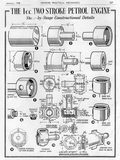 In January 1938, NPM began a six part series on the construction of a 1cc, two-stroke, spark ignition engine for home construction designed by one WH Deller—obviously the "W.H.D." from the November 1936 issue. The engine was designed to be built completely from the plans, with no castings required. A side-bar advised builders not wishing to wait for all parts to appear that blueprints could be purchased for five shillings. That may have been a wise purchase as the magazine "plans", while most attractive and beautifully drawn, are not quite what one might expect in an engineering drawing, with conflicting sizes given for minor details like the cylinder bore! For the curious, links to complete scans of the plans and instructions appear below and we thank John Bell (UK) for providing the complete set.
In January 1938, NPM began a six part series on the construction of a 1cc, two-stroke, spark ignition engine for home construction designed by one WH Deller—obviously the "W.H.D." from the November 1936 issue. The engine was designed to be built completely from the plans, with no castings required. A side-bar advised builders not wishing to wait for all parts to appear that blueprints could be purchased for five shillings. That may have been a wise purchase as the magazine "plans", while most attractive and beautifully drawn, are not quite what one might expect in an engineering drawing, with conflicting sizes given for minor details like the cylinder bore! For the curious, links to complete scans of the plans and instructions appear below and we thank John Bell (UK) for providing the complete set.
Articles:
 Prelude
Prelude
 Part I
Part I
 Part II, p1
Part II, p1
 Part II, p2
Part II, p2
 Part III, p1
Part III, p1
 Part III, p2
Part III, p2
 Part IV
Part IV
 Part V
Part V
 Part VI
Part VI
 Part VII, p1
Part VII, p1
 Part VII, p2
Part VII, p2
Drawings:
 Crankcase and Rear Cover
Crankcase and Rear Cover
 Crankshaft and Bush
Crankshaft and Bush
 Cylinder and Bypass Cover
Cylinder and Bypass Cover
 General Arrangement, misc details
General Arrangement, misc details
 Piston, Cylinder Head, Spark-plug, Conrod
Piston, Cylinder Head, Spark-plug, Conrod
 Timer and Carburetter Body
Timer and Carburetter Body
The bore, stroke and displacement are a bit nebulous. The crankshaft throw in the drawing is shown as 1/4" for a 1/2" stroke. This is reinforced by the introductory paragraph of Part I, but it may have been less, as we shall see. Also in Part I of the article, a figure of 7/16" (0.438) is quoted for the bore. However, the Cylinder drawing shows two different dimensions for the bore, neither of which is 7/16"! Namely, 15/32" (0.469), and 0.432", the latter being within cooee of 7/16, but not spot-on. On the piston sheet we find agreement with the 0.432" dimension, so using that, we end up with a displacement of 0.073 cuin (1.2cc), significantly larger than the quoted size of 1cc, so perhaps the stroke was not always 1/2". Or perhaps log tables and slide-rules were less reliable in those days.
It is interesting to note that in November 1937, plans for Irwin Ohlsson's 0.12 cuin engine had appeared in the American magazine Popular Mechanics (part of the Hurst stable of publications) [1]. I would doubt, given the speed of communications at the time, that the editor of Practical Mechanics was even aware of this fact, so "me too" rivalry is unlikely. Still, the publications are contemporaneous, and with the Deller's displacement being about half that of the Ohlsson, a "ours is smaller than yours" bit of one-upmanship is possible.
While making meaningless comparisons between the first small spark engines, mention can be made of the ELFs. Although they were production engines, not home-builts (some may argue  ), Dan Calkin's ELF "Corncob" of 0.136 cuin appeared in 1935 [2]. These were superseded in 1939 by the smaller still Model 10 ELFs of 0.097 cuin displacement [3]. This makes the Deller one of the earliest, successful small engine designs (depending on the skills of the builder, of course).
), Dan Calkin's ELF "Corncob" of 0.136 cuin appeared in 1935 [2]. These were superseded in 1939 by the smaller still Model 10 ELFs of 0.097 cuin displacement [3]. This makes the Deller one of the earliest, successful small engine designs (depending on the skills of the builder, of course).
Technical Description:
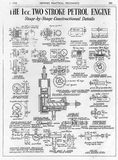 The Deller contains a number of innovations that set it apart from other designs. First of these is the dual purpose cam machined onto the back face of the prop driver. This is best understood from the sectioned General Arrangement detail. The "carburetor body" is a T-shaped tube open at all ends. One end of the T cross-piece threads into the crankcase cavity, while the vertical part forms an "up-draft" inlet. A spring loaded plunger is then inserted into the forward facing opening where it rides in contact with the rear face of the prop driver/cam. The cam cut-out allows this plunger to open the inlet around TDC. Another cam machined onto the perimeter of the driver (and not obvious on the drawing) operates the points.
The Deller contains a number of innovations that set it apart from other designs. First of these is the dual purpose cam machined onto the back face of the prop driver. This is best understood from the sectioned General Arrangement detail. The "carburetor body" is a T-shaped tube open at all ends. One end of the T cross-piece threads into the crankcase cavity, while the vertical part forms an "up-draft" inlet. A spring loaded plunger is then inserted into the forward facing opening where it rides in contact with the rear face of the prop driver/cam. The cam cut-out allows this plunger to open the inlet around TDC. Another cam machined onto the perimeter of the driver (and not obvious on the drawing) operates the points.
Next, notice the spark plug. Given the size, Deller probably had little choice but to make this himself. But rather than simply scale down common practice, his design resembles the glow-heads made familiar to us by Cox engines—where plug and combustion chamber are combined into a screw-on unit. The piston is a bit unusual, although not unique. The wrist pin carrier from aluminum with a screw on cast iron sleeve is a reasonable attempt to minimize the reciprocating mass. Some designs have used this to type of design to contain the floating wrist pin, but as the Deller piston carries a baffle, the wrist pin hole has been drilled through both to prevent unwanted rotation of the outer sleeve. Finally, there's the helical oil groove on the shaft. This feature has appeared on a small number of older engines and has been suggested as a fix for engines prone to emitting excess oil (and fuel in the case of two-strokes) via the front bearing. Take note that this novel idea will only work as advertised for one direction of rotation.
Interpretations:
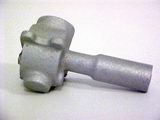
|
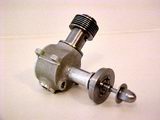
|

|
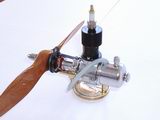 Les Stone's Deller is different again, although he worked from source material obtained from Graham Pod. Les has fitted a backplate mounted tank, a conventional (though shop-made) spark plug, threaded into a blind bore cylinder, an adjustable advance/retard moving point mount (similar to the Pod engine), and a flexible needle extension. Graham points out that Les has chosen to retain his cylinder using two screws. A sensible precaution as the Deller plans show two different threads for the cylinder and the hole in the case it should screw into! Les likes the contrast provided by different metals, so his carburetor body is brass. For more pictures of Les' Deller, visit the Les Stone Tribute page of the Engine Gallery.
Les Stone's Deller is different again, although he worked from source material obtained from Graham Pod. Les has fitted a backplate mounted tank, a conventional (though shop-made) spark plug, threaded into a blind bore cylinder, an adjustable advance/retard moving point mount (similar to the Pod engine), and a flexible needle extension. Graham points out that Les has chosen to retain his cylinder using two screws. A sensible precaution as the Deller plans show two different threads for the cylinder and the hole in the case it should screw into! Les likes the contrast provided by different metals, so his carburetor body is brass. For more pictures of Les' Deller, visit the Les Stone Tribute page of the Engine Gallery.
Conclusion:
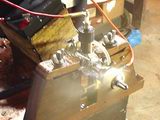 The Deller 1cc (whatever...) is certainly an unusual engine with a number of talking points. As we can see here with Les Stone's engine, the cam actuated inlet valve is practical and the engine certainly runs. But Les is a most accomplished builder and has years of experience to draw upon. How well a first time builder with more primitive equipment may have fared in the late 1930's could well be another matter entirely, especially given the large amounts of interpretation required by the plans and instructions. Even though the engine was unknown to me at the outset (not surprising some would say), it has endured in engine building circles for over 60 years—no mean feat.
The Deller 1cc (whatever...) is certainly an unusual engine with a number of talking points. As we can see here with Les Stone's engine, the cam actuated inlet valve is practical and the engine certainly runs. But Les is a most accomplished builder and has years of experience to draw upon. How well a first time builder with more primitive equipment may have fared in the late 1930's could well be another matter entirely, especially given the large amounts of interpretation required by the plans and instructions. Even though the engine was unknown to me at the outset (not surprising some would say), it has endured in engine building circles for over 60 years—no mean feat.
References:
| [1] | Schroeder, RJ: Winged Motors: The Original Ohlsson, Strictly Internal Combustion, Volume 1, Number 6, Oct/Nov 1988, p16. |
| [2] | Brown, JJ: Dan Calkin and His ELFs, Model Aviation Books, Santa Ana, 1999, p89. |
| [3] | ibid. p91. |
![]()
